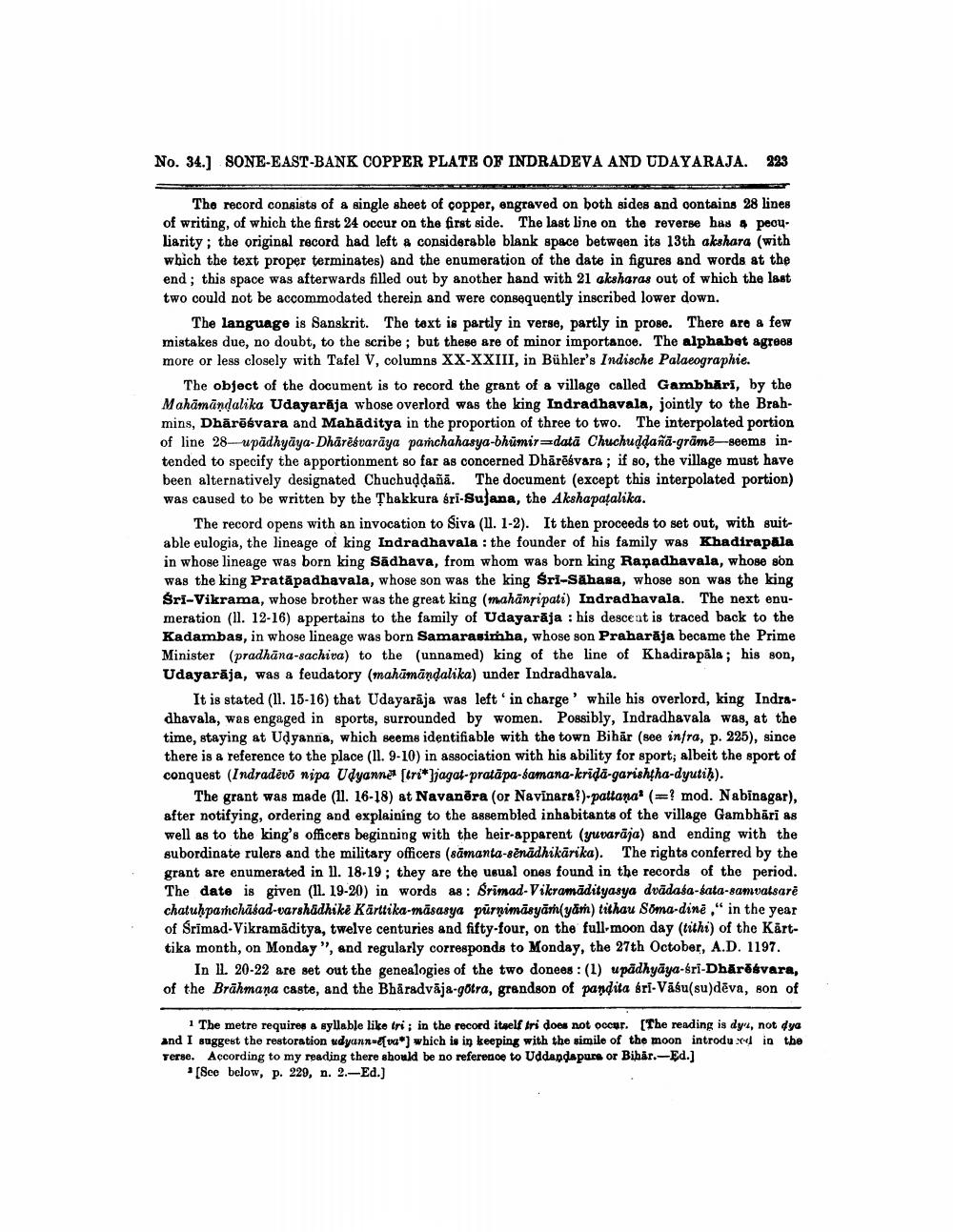________________
No. 34.) SONE-EAST-BANK COPPER PLATE OF INDRADEVA AND UDAYARAJA. 223
DINANCIARE ALLAR
The record consists of a single sheet of copper, engraved on both sides and contains 28 lines of writing, of which the first 24 occur on the first side. The last line on the reverse has * peouliarity; the original record had left & considerable blank space between its 13th akshara (with which the text proper terminates) and the enumeration of the date in figures and words at the end ; this space was afterwards filled out by another hand with 21 aksharas out of which the last two could not be accommodated therein and were consequently inscribed lower down.
The language is Sanskrit. The text is partly in verse, partly in proge. There are a few mistakes due, no doubt, to the scribe; but these are of minor importance. The alphabet agrees more or less closely with Tafel V, columns XX-XXIII, in Bühler's Indische Palaeographie.
The object of the document is to record the grant of a village called Gambhari, by the Mahāmāndalika Udayarāja whose overlord was the king Indradhavala, jointly to the Brahmins, Dhārēśvara and Mahāditya in the proportion of three to two. The interpolated portion of line 28-upādhyāya-Dhårēsvarāya pańchahasya-bhūmir=data Chuchuddaña-grāmë-seems intended to specify the apportionment so far as concerned Dhārēsvara; if so, the village must have been alternatively designated Chuchuddañā. The document (except this interpolated portion) was caused to be written by the Thakkura sri-Sujana, the Akshapatalika.
The record opens with an invocation to Siva (11. 1-2). It then proceeds to set out, with suitable eulogia, the lineage of king Indradhavala : the founder of his family was Khadirapala in whose lineage was born king Sādhava, from whom was born king Rapadhavala, whose son was the king Pratāpadhavala, whose son was the king Sri-Sähasa, whose son was the king Sri-Vikrama, whose brother was the great king (mahānripati) Indradhavala. The next enumeration (11. 12-16) appertains to the family of Udayarāja : his descent is traced back to the Kadambas, in whose lineage was born Samarasimha, whose son Praharāja became the Prime Minister (pradhāna-sachiva) to the (unnamed) king of the line of Khadirapāla; his son, Udayarāja, was a feudatory (mahūmāndalika) under Indradhavala.
It is stated (11. 15-16) that Udayarāja was left in charge while his overlord, king Indradhavala, was engaged in sports, surrounded by women. Possibly, Indradhavala was, at the time, staying at Udyanna, which seems identifiable with the town Bihar (see infra, p. 225), since there is a reference to the place (11. 9-10) in association with his ability for sport; albeit the sport of conquest (Indradevo nipa Udyanne (tri*]jagat-pratāpa-samana-krida-garishtha-dyutih).
The grant was made (11. 16-18) at Navanēra (or Navinara?)-pattana' (? mod. Nabinagar). after notifying, ordering and explaining to the assembled inhabitants of the village Gambhāri as well as to the king's officers beginning with the heir-apparent (yuvarāja) and ending with the subordinate rulers and the military officers (sāmanta-8ēnādhikarika). The rights conferred by the grant are enumerated in 11. 18-19; they are the usual ones found in the records of the period. The date is given (11. 19-20) in words as: Srimad-Vikramadityasya dvādasa-sata-samvatsare chatuhpanchāśad-varshadhike Kärttika-māsasya pūrnimāsyām(yan) tithau Soma-dinë," in the year of Srimad Vikramāditya, twelve centuries and fifty-four, on the full-moon day (tithi) of the Kärttika month, on Monday", and regularly corresponds to Monday, the 27th October, A.D. 1197.
In 11. 20-22 are set out the genealogies of the two donees: (1) upadhyāya-bri-Dhārēsvara, of the Brāhmaṇa caste, and the Bharadvāja-gotra, grandson of pandita sri-Vāsu(su)dēva, son of
1 The metre requires a syllable like tri; in the record itzelf tri does not occur. [The reading is dy, not dya and I suggest the restoration wdyann-awa®) which is in keeping with the simile of the moon introduced in the Terse. According to my reading there should be no reference to Uddapdapure or Bihar.-Ed.]
*[See below, p. 229, n. 2.-Ed.)




